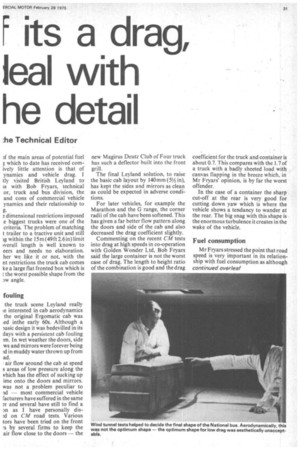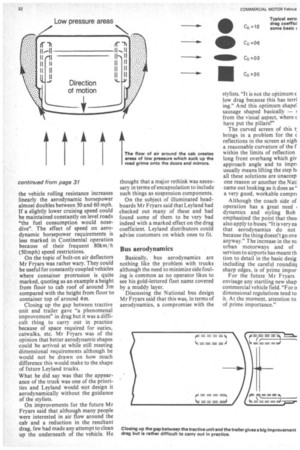leal with he detail
Page 33

Page 34

If you've noticed an error in this article please click here to report it so we can fix it.
:he Technical Editor
the main areas of potential fuel g which to date has received cornively little attention is that of ynamics and vehicle drag. I tly visited British Leyland to is with Bob Fryars, technical or, truck and bus division, the and cons of commercial vehicle ynamics and their relationship to g.
dimensional restrictions imposed .e biggest trucks were one of the criteria. The problem of matching t trailer to a tractive unit and still ig within the 15m (49 ft 2.6 in) limit overall length is well known to eers and needs no elaboration. her we like it or not, with the nt restrictions the truck cab comes ke a large flat fronted box which is the worst possible shape from the aw angle.
fouling
the truck scene Leyland really le interested in cab aerodynamics the original Ergomatic cab was Led inthe early 60s. Although a )asic design it was bedevilled in its days with a persistent cab fouling m. In wet weather the doors, side ws and mirrors were forever being A in muddy water thrown up from ad.
air flow around the cab at speed s areas of low pressure along the vhich has the effect of sucking up ime onto the doors and mirrors. was not a problem peculiar to — most commercial vehicle facturers have suffered in the same N. and several have still to find a )n as I have personally disA on CM road tests. Various tors have been tried on the front 7s by several firms to keep the air flow close to the doors — the new Magirus Deutz Club of Four truck has such a deflector built into the front grill.
The final Leyland solution, to raise the basic cab layout by 140mm (51/2 in), has kept the sides and mirrors as clean as could be expected in adverse conditions.
For later vehicles, for example the Marathon and the G range, the corner radii of the cab have been softened. This has given a far better flow pattern along the doors and side of the cab and also decreased the drag coefficient slightly.
Commenting on the recent CM tests into drag at high speeds in co-operation with Golden Wonder Ltd, Bob Fryars said the large container is not the worst case of drag. The length to height ratio of the combination is good and the drag coefficient for the truck and container is about 0.7. This compares with the 1.7 of a truck with a badly sheeted load with canvas flapping in the breeze which, in Mr Fryars' opinion, is by far the worst offender.
In the case of a container the sharp cut-off at the rear is very good for cutting down yaw which is where the vehicle shows a tendancy to wander at the rear. The big snag with this shape is the enormous turbulence it creates in the wake of the vehicle.
Fuel consumption
Mr Fryars stressed the point that road speed is very important in its relationship with fuel consumption as although continued overleaf continued fiat?, page 31
the vehicle rolling resistance increases linearly the aerodynamic horsepower almost doubles between 50 and 60 mph. If a slightly lower cruising speed could be maintained constantly on level roads "the fuel consumption would nosedive". The effect of speed on aerodynamic horsepower requirements is less marked in Continental operation because of their frequent 80km/ h (50mph) speed restrictions. On the topic of bolt-on air deflectors Mr Fryars was rather wary. They could be useful for constantly coupled vehicles where container protrusion is quite marked, quoting as an example a height from floor to cab roof of around 3m compared with the height from floor to container top of around 4m.
Closing up the gap between tractive unit and trailer gave "a phenomenal improvement" in drag but it was a difficult thing to carry out in practice because of space required for suzies, catwalks, etc. Mr Fryars was of the opinion that better aerodynamic shapes could be arrived at while still meeting dimensional requirements although he would not be drawn on how much difference this would make to the shape of future Leyland trucks.
What he did say was that the appearance of the truck was one of the priorities and Leyland would liot design it aerodynamically without the guidance of the stylists.
On improvements for the future Mr Fryars said that although many people were interested in air flow around the cab and a reduction in the resultant drag, few had made any attempt to clean up the underneath of the vehicle. He tThe flow of air around the cab creates areas of low pressure which suck up the road grime onto the doors and mirrors. thought that a major rethink was necessary in terms of encapsulation to include such things as suspension components.
On the subject of illuminated headboards Mr Fryars said that Leyland had checked out many of these and had found some of them to be very bad indeed with a marked effect on the drag coefficient. Leyland distributors could advise customers on which ones to fit.
Bus aerodynamics
Basically, bus aerodynamics are nothing like the problem with trucks although the need to minimize side fouling is common as no operator likes to see his gold-lettered fleet name covered by a muddy layer.
Discussing the National bus design Mr Fryars said that this was, in terms of aerodynamics, a compromise with the stylists. "It is not the optimums low drag because this has terni ing." And this optimum shape': sausage shaped basically — from the visual aspect, where c have put the pillars?"
The curved screen of this t: brings in a problem for the reflections in the screen at nigh a reasonable curvature of the f within the limits of reflection long front overhang which giv approach angle and to impri usually means lifting the step hi all these solutions are unaccep one reason or another the Nati came out looking as it does as " a very good, workable comprc Although the coach side of operation has a great need dynamics and styling Bob emphasized the point that thesi also apply to buses. "It is very ea that aerodynamics do not because the thing doesn't go ove anyway." The increase in the nu urban motorways and of services to airports has meant th tion to detail in the basic desig including the careful roundini sharp edges, is of prime impor For the future Mr Fryars envisage any startling new shap commercial vehicle field. "For o dimensional regulations tend to it. At the moment, attention to • of prime importance."




























































































